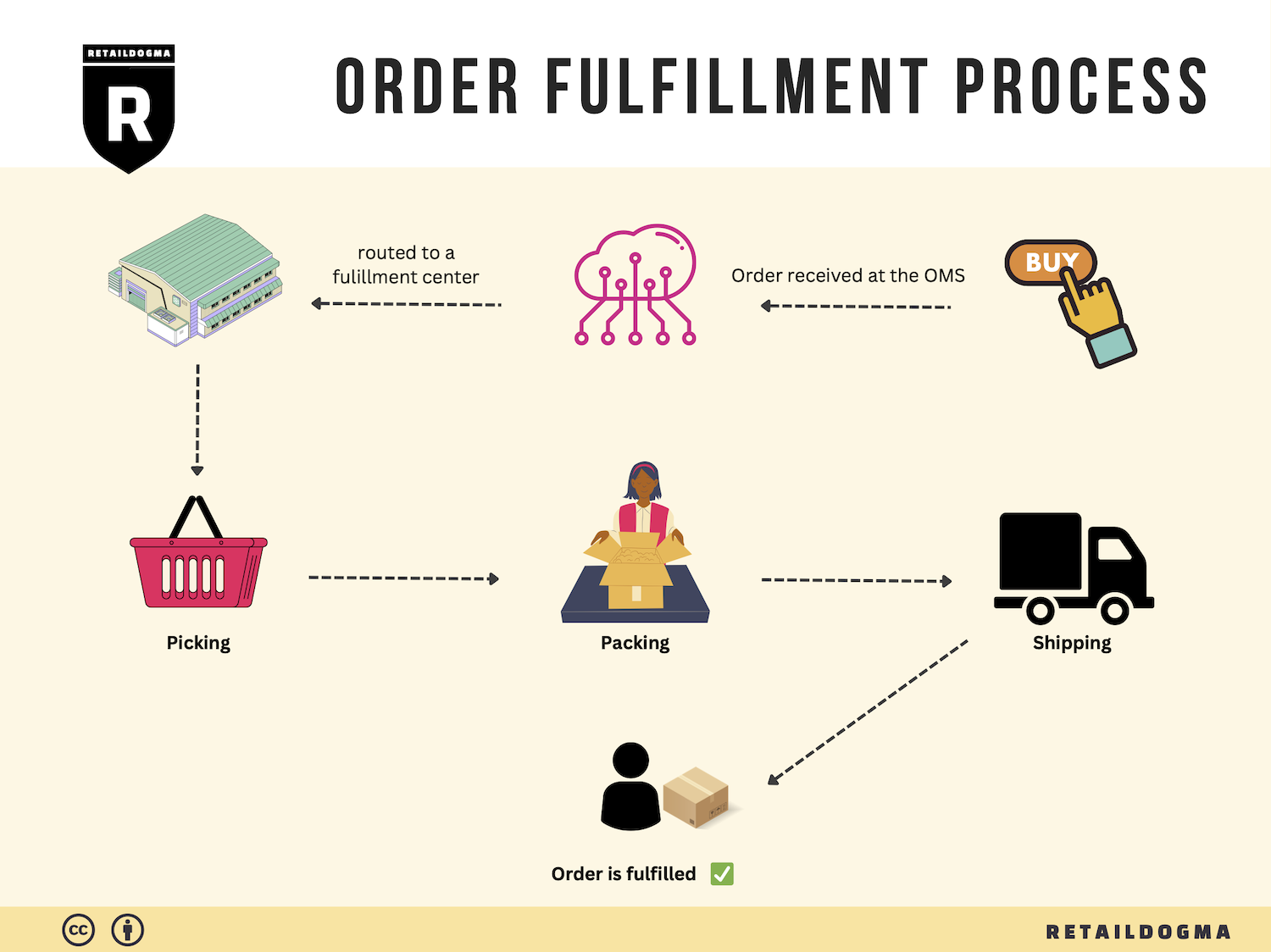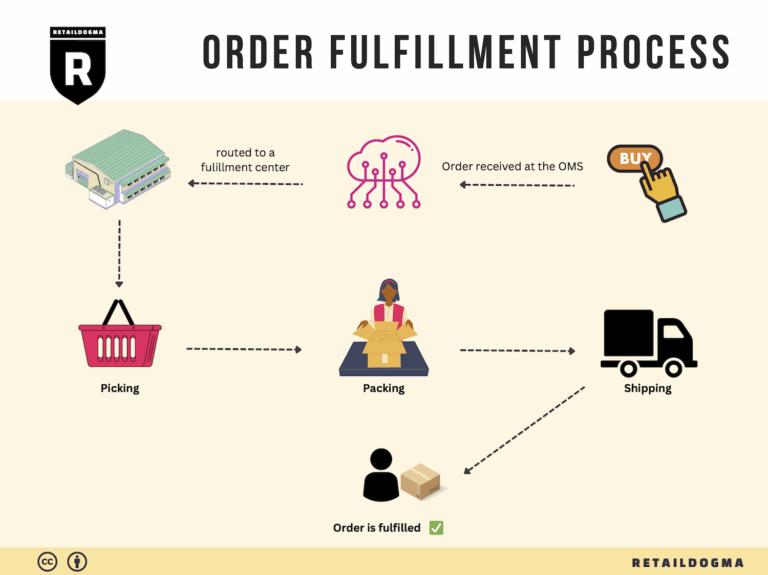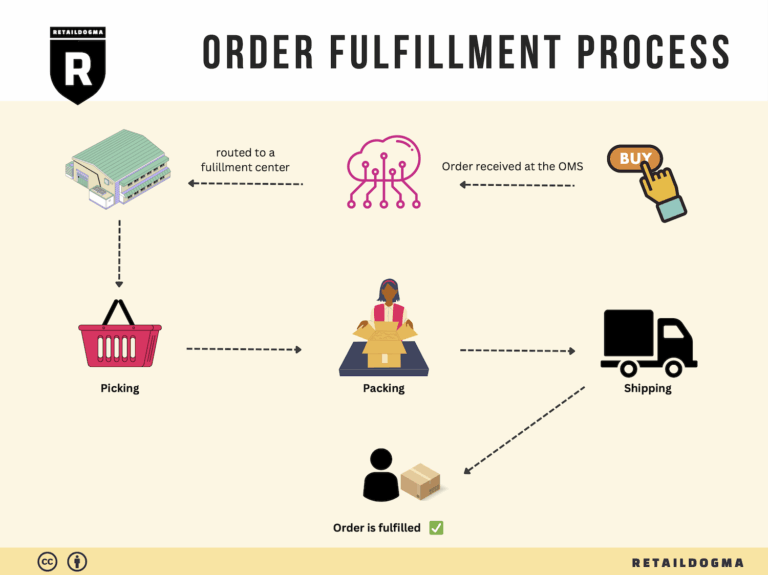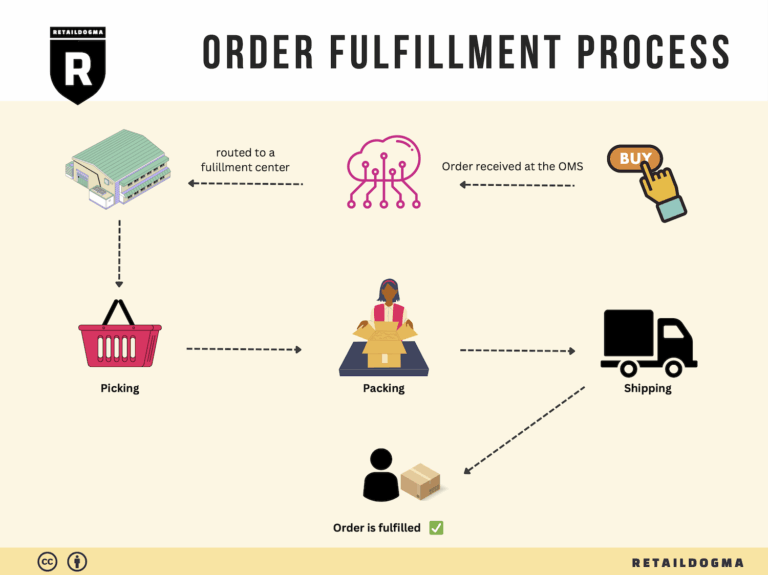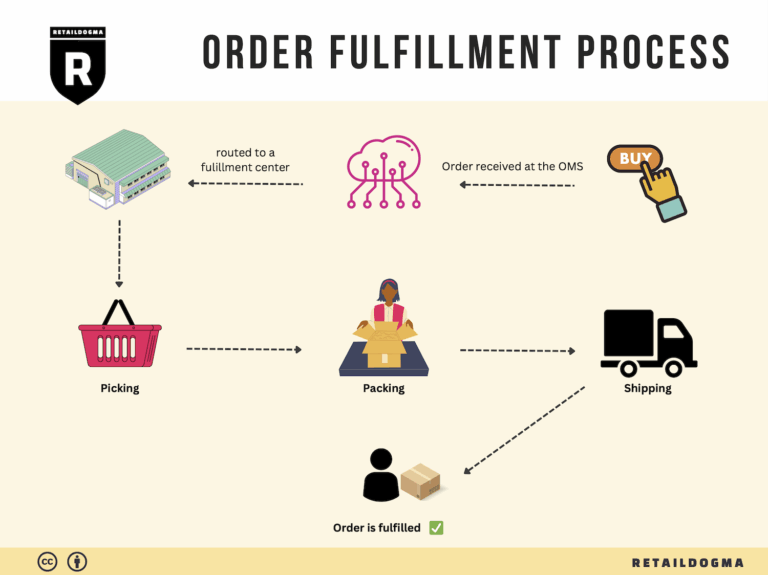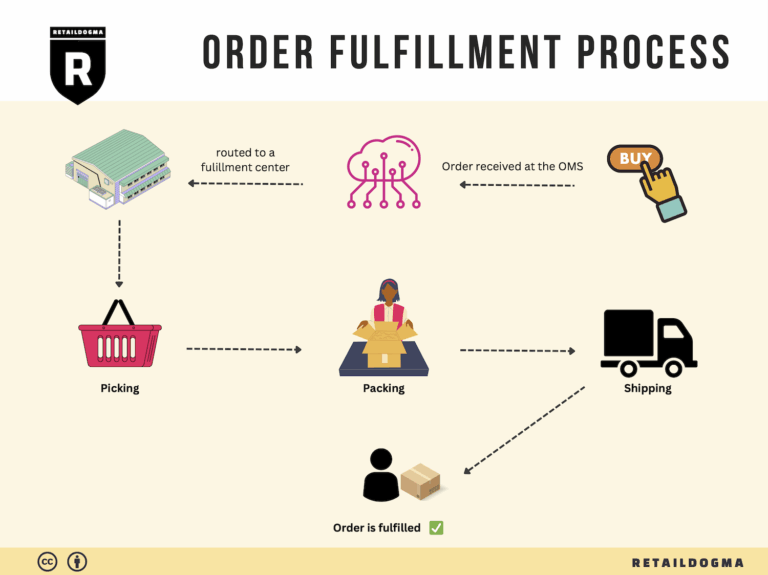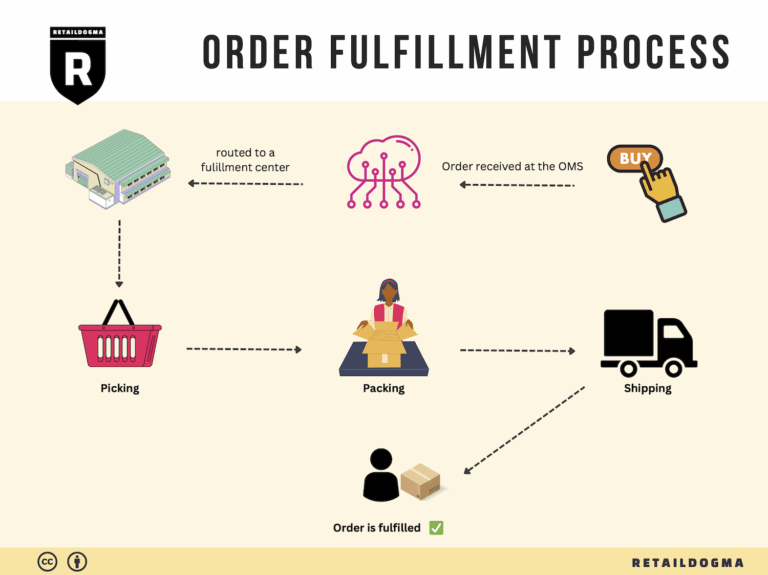What Is A Fulfillment Center? A Complete Guide (2025)
What is E-commerce Fulfillment? An Introduction for Growing Businesses
Understanding the Fulfillment Process
For many growing e-commerce businesses, the excitement of increasing sales can quickly turn into overwhelm when faced with the logistics of packing and shipping orders. As your online store starts to gain traction, managing the fulfillment process can become a daunting task. The sheer volume of orders, coupled with the need for timely delivery, can strain your resources and distract you from focusing on other critical aspects of your business.
At its core, e-commerce fulfillment is the process of getting a product from your inventory to the customer’s doorstep. This involves several key steps, including receiving inventory, processing orders, picking and packing products, and finally shipping them out to customers. A streamlined fulfillment process not only enhances customer satisfaction but also drives repeat business, making it a vital component of your overall e-commerce strategy.
In this guide, we will delve into various fulfillment models available to e-commerce businesses. You’ll learn about Third-Party Logistics (3PL) and Fulfillment by Amazon (FBA), among others, highlighting their unique features and benefits. We will also explore the core services that fulfillment partners typically offer, such as inventory management, order processing, and returns handling.
Choosing the right fulfillment partner is crucial for scaling your operations efficiently. We’ll provide practical tips on what to look for when selecting a fulfillment provider, including their technology capabilities, shipping options, and customer service. Additionally, we will discuss pricing structures and how to assess the cost-effectiveness of different fulfillment solutions.
Our goal with this guide is to empower e-commerce business owners, operations managers, and entrepreneurs like you to make informed decisions about your logistics. By understanding the nuances of e-commerce fulfillment, you can optimize your processes, reduce operational headaches, and ultimately, enhance your customer experience. Let’s dive into the world of e-commerce fulfillment and equip your business for sustainable growth.
What You’ll Learn In This Guide
- What is E-commerce Fulfillment? An Introduction for Growing Businesses
- The Order Fulfillment Process: From ‘Buy’ Button to Customer’s Door
- Comparing Fulfillment Models: In-House vs. 3PL vs. Dropshipping
- A Deep Dive into Amazon FBA: Pros, Cons, and Who It’s For
- Core Services Offered by Fulfillment Centers
- How to Choose a Fulfillment Partner: A 6-Point Checklist
- Understanding Fulfillment Pricing: A Breakdown of Common Fees
- Frequently Asked Questions (FAQs) about Fulfillment
- Conclusion: Is Outsourcing Fulfillment the Right Move for Your Business?
- Important Disclaimer
The Order Fulfillment Process: From ‘Buy’ Button to Customer’s Door
1. Receiving Inventory
The first step in the order fulfillment process is receiving inventory. This involves the acceptance of goods from suppliers and manufacturers into your warehouse or fulfillment center. Upon arrival, each shipment is checked against the purchase order to ensure accuracy in terms of quantity and quality.
Importance: Proper receiving is crucial as it lays the foundation for inventory management. If discrepancies are found—such as missing items or damaged goods—immediate action can be taken to resolve these issues before they affect future orders.
Key Term: SKU (Stock Keeping Unit) – This unique identifier is assigned to each product, facilitating easy tracking and management throughout the inventory process.
2. Warehouse Storage
Once inventory is received, it must be stored efficiently within the warehouse. This step involves categorizing and placing products in designated areas based on factors like product type, size, and demand frequency. Strategic storage solutions, such as shelving, bins, and pallet racks, help optimize space and accessibility.
Importance: Effective warehouse storage minimizes retrieval times and reduces the risk of damage or loss. By organizing products logically, businesses can enhance operational efficiency, which is particularly important as order volumes increase during peak seasons.
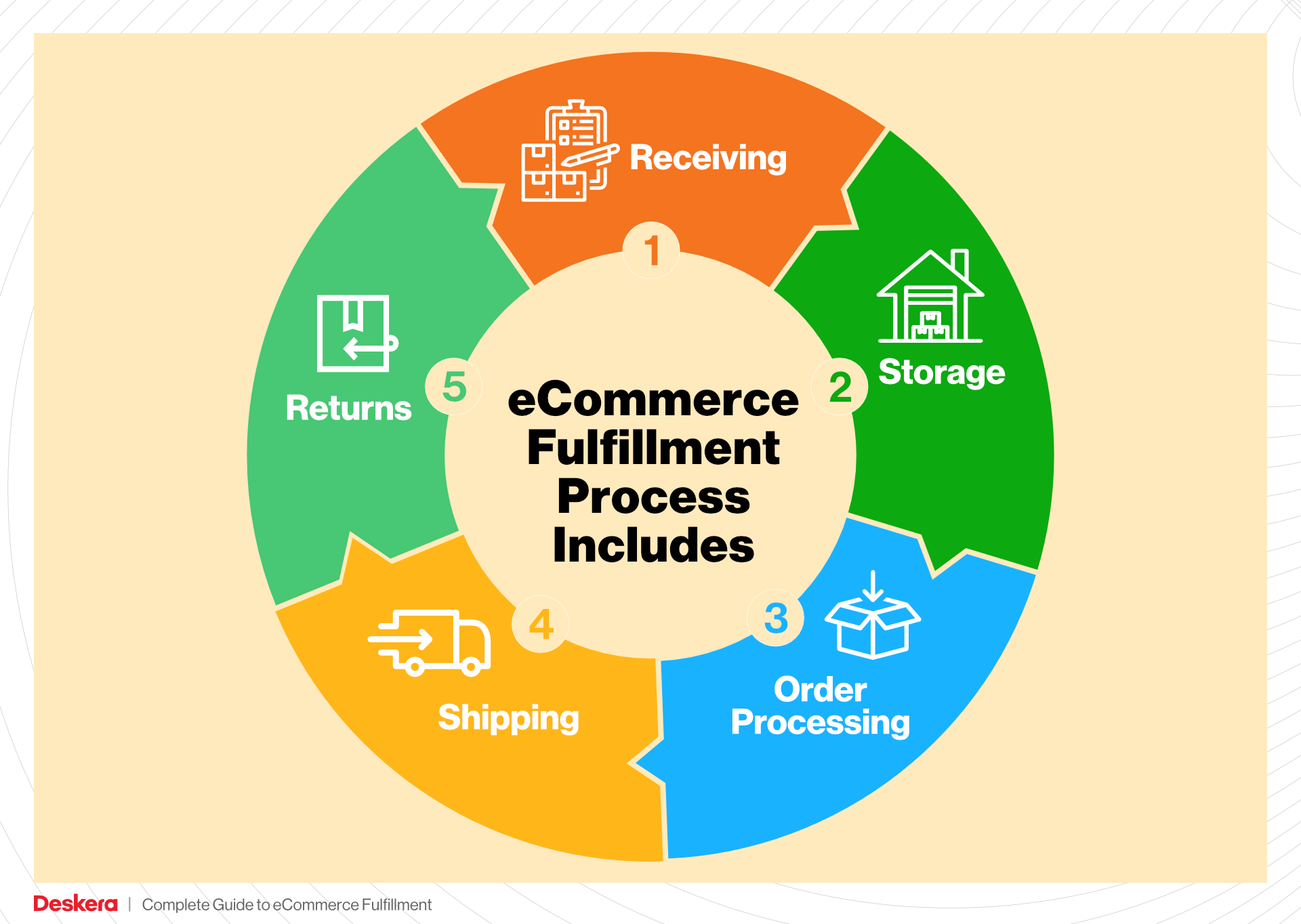
Key Term: ABC Analysis – This inventory categorization technique prioritizes items based on their importance to the business, helping to allocate resources and space more effectively.
3. Order Picking
Order picking is the process of selecting items from the warehouse to fulfill customer orders. This step often utilizes a “pick list,” which details the items and quantities needed for each order. Various picking methods can be employed, including single-order picking, batch picking, or zone picking, depending on the scale of operations.
Importance: Accurate order picking is vital to maintaining customer satisfaction. Errors during this stage can lead to incorrect shipments, which can harm the business’s reputation and result in costly returns or exchanges.
Key Term: Pick List – A document or digital tool that outlines the specific items and quantities needed for fulfilling orders, guiding warehouse staff in their picking tasks.
4. Order Packing
After items are picked, they move to the packing stage. During this process, products are securely packaged for shipping. This includes selecting appropriate packing materials, labeling, and preparing any necessary documentation (such as invoices or shipping labels).
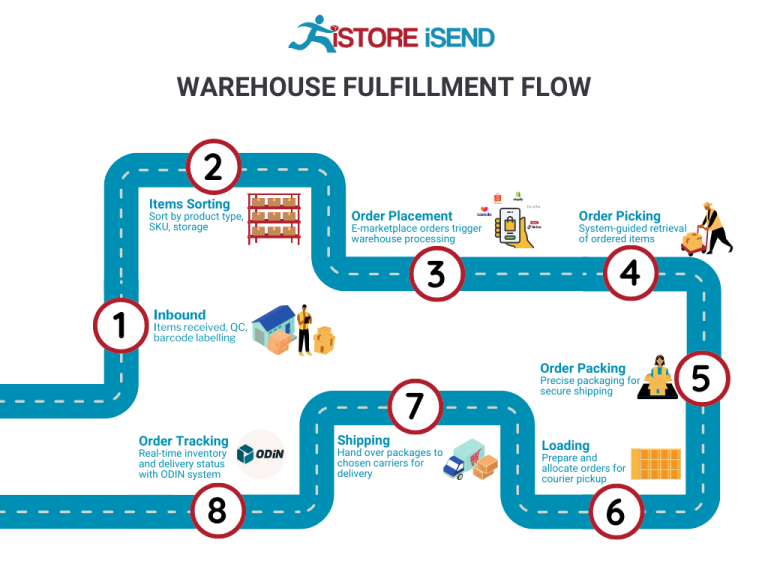
Importance: Packing is essential not only for protecting products during transit but also for ensuring compliance with shipping regulations. Well-packed orders minimize the risk of damage and enhance the overall customer experience, as well-presented packages can create a positive impression.
Key Term: Packaging Materials – These include boxes, bubble wrap, and tape, which are crucial for safeguarding items during shipping and ensuring they arrive in optimal condition.
5. Shipping & Delivery
The final step in the order fulfillment process is shipping and delivery. Once packages are packed, they are handed over to shipping carriers for transportation to the customer’s address. Businesses must choose reliable carriers and manage logistics to ensure timely deliveries.
Importance: Efficient shipping and delivery are critical in today’s e-commerce landscape, where customers expect fast and reliable service. Delays can lead to dissatisfaction and lost sales, making it essential to streamline this final step in the fulfillment process.
Key Term: Last-Mile Delivery – This term refers to the final leg of the shipping process, where the product is delivered from a transportation hub to the end customer. Optimizing last-mile delivery can significantly enhance customer satisfaction and reduce costs.
By understanding and effectively managing each step of the order fulfillment process, e-commerce businesses can enhance operational efficiency, improve customer satisfaction, and ultimately drive growth. Implementing best practices at each stage, from receiving inventory to shipping, will ensure that your business can scale successfully while maintaining high service levels.
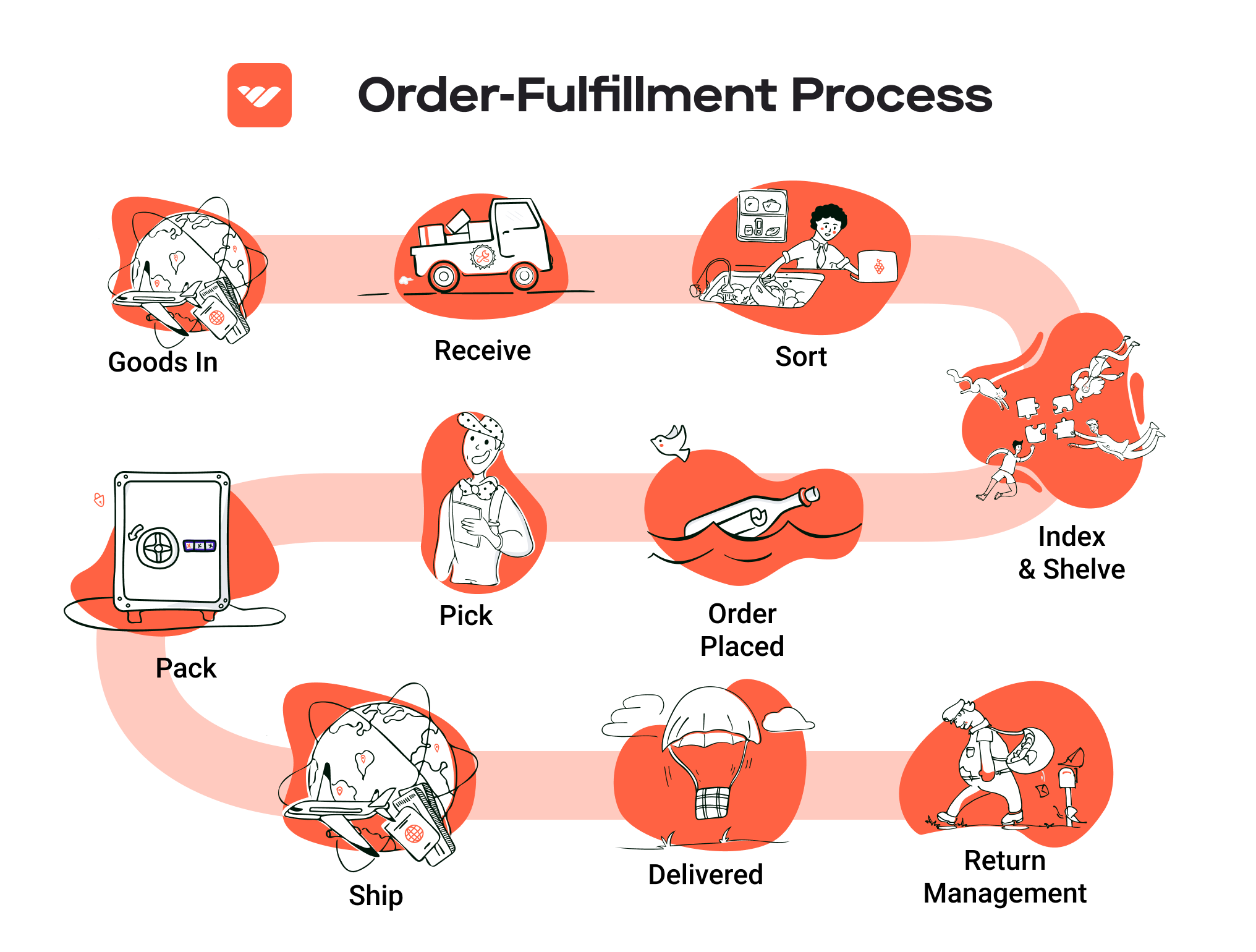
Comparing Fulfillment Models: In-House vs. 3PL vs. Dropshipping
Fulfillment Models Overview
When it comes to scaling e-commerce operations, choosing the right fulfillment model is crucial. Each model has its distinct characteristics, advantages, and disadvantages, making it essential for business owners to evaluate their current stage and future goals. Below is a comparative overview of three prevalent fulfillment models: In-House Fulfillment, Third-Party Logistics (3PL), and Dropshipping.
| Model | Who Handles Inventory | Best For (Business Stage) | Key Advantage | Key Disadvantage |
|---|---|---|---|---|
| In-House Fulfillment | The business itself | Established businesses with stable sales | Greater control over inventory and fulfillment process | High upfront investment and operational costs |
| Third-Party Logistics (3PL) | A third-party provider | Growing businesses looking to scale | Flexibility and scalability without heavy investment | Less control over inventory and potential communication issues |
| Dropshipping | Supplier or manufacturer | Startups and businesses with limited capital | Low overhead costs and minimal risk | Lower profit margins and reliance on supplier reliability |
In-House Fulfillment
In-House Fulfillment involves managing inventory and shipping operations within the business. This model is best suited for established businesses with a stable customer base and consistent sales. Companies that adopt this model typically invest in warehouse space, staff, and technology to manage their logistics.
Key Advantages: One of the primary advantages of in-house fulfillment is the level of control it provides. Businesses can oversee their entire inventory management and shipping processes, ensuring that quality standards are met. This model allows for customized packaging and branding, which can enhance customer experience. Additionally, businesses can respond quickly to changes in demand, as they have direct access to their inventory.
Key Disadvantages: However, in-house fulfillment comes with significant challenges. The initial investment in warehousing, staffing, and technology can be substantial. Additionally, as order volumes increase, operational costs may rise, leading to inefficiencies if not managed properly. Businesses also bear the full responsibility for logistics, including shipping errors and delays, which can impact customer satisfaction.
Third-Party Logistics (3PL)
Third-Party Logistics (3PL) providers are specialized companies that manage logistics functions for businesses. This model is particularly advantageous for growing businesses that want to scale their operations without the burden of managing logistics themselves.
Key Advantages: One of the most significant advantages of 3PL is flexibility. Businesses can scale their logistics operations up or down based on demand without making substantial investments. 3PL providers often have established systems and expertise in logistics, which can lead to improved efficiency and cost savings. They can handle complex logistics tasks, including warehousing, inventory management, and shipping, allowing businesses to focus on core activities such as marketing and sales.
Key Disadvantages: On the downside, using a 3PL means relinquishing some control over inventory and fulfillment processes. Communication can sometimes be an issue, particularly if the 3PL provider is not aligned with the business’s goals or customer service standards. Additionally, businesses may face challenges related to integration with their existing systems, which can complicate operations.
Dropshipping
Dropshipping is a fulfillment model where the retailer does not keep the products it sells in stock. Instead, when a retailer sells a product, it purchases the item from a third party (usually a wholesaler or manufacturer) and has it shipped directly to the customer. This model is particularly appealing for startups or businesses with limited capital.
Key Advantages: The primary advantage of dropshipping is the low overhead costs. Since there’s no need to invest in inventory or warehouse space, businesses can start with minimal risk. This model allows entrepreneurs to test new products without the financial burden of upfront inventory costs. Additionally, it enables retailers to offer a wide range of products without the constraints of storage space.
Key Disadvantages: However, dropshipping also has its drawbacks. Profit margins can be lower compared to other fulfillment models due to the reliance on suppliers. Businesses are also at the mercy of their suppliers regarding inventory levels and shipping times, which can lead to customer dissatisfaction if products are out of stock or delays occur. Furthermore, branding opportunities are limited since packaging and shipping are handled by the supplier, potentially diluting brand identity.
Conclusion
Choosing the right fulfillment model is a critical decision that can significantly impact an e-commerce business’s scalability and operational efficiency. In-house fulfillment offers control and customization but requires substantial investment. Third-party logistics provide flexibility and expertise, making it suitable for growing businesses. Dropshipping presents a low-risk entry point for startups but comes with challenges related to margins and supplier reliability. By understanding the nuances of each model, e-commerce business owners can make informed decisions that align with their operational goals and market demands.
A Deep Dive into Amazon FBA: Pros, Cons, and Who It’s For
Understanding Fulfillment by Amazon (FBA)
Fulfillment by Amazon (FBA) is a service offered by Amazon that allows e-commerce sellers to store their products in Amazon’s fulfillment centers. When a customer places an order, Amazon takes care of storage, packaging, shipping, and customer service on behalf of the seller. This service is designed to simplify the logistics process for sellers, allowing them to focus on other aspects of their business, such as marketing and product development.
How FBA Works
-
Setup: To use FBA, sellers must create an Amazon seller account and register for FBA. They then prepare their products according to Amazon’s guidelines, which include labeling and packaging requirements.
-
Shipping Inventory: Sellers send their inventory to one or more of Amazon’s fulfillment centers. Amazon will provide shipping labels and instructions on how to properly pack and send products.
-
Storage: Once products arrive at the fulfillment center, they are stored until an order is placed. Amazon’s warehouses are equipped to handle large volumes of inventory, which can be beneficial for sellers with fluctuating stock levels.
-
Order Fulfillment: When a customer orders a product, Amazon picks, packs, and ships the item directly to the customer. The seller’s products are eligible for Amazon Prime and other Amazon services, enhancing their visibility and attractiveness to buyers.
-
Customer Service and Returns: Amazon manages customer inquiries and returns, providing a level of service that many customers trust. This can significantly enhance the overall customer experience and reduce the burden on sellers.
Pros of Using FBA
1. Prime Eligibility
One of the most significant advantages of FBA is that products become eligible for Amazon Prime. This can lead to increased sales, as Prime members tend to prefer items that are eligible for free and fast shipping. The Prime badge is a powerful trust signal that can enhance a product’s appeal.
2. Customer Trust
Amazon is a well-known brand, and customers often feel more secure purchasing items fulfilled by Amazon due to their reputation for reliable service and customer satisfaction. This trust can translate into higher conversion rates for sellers using FBA.
3. Multi-Channel Fulfillment
FBA allows sellers to utilize Amazon’s fulfillment services across multiple sales channels. Whether selling on their own website or through other platforms, sellers can use FBA to handle logistics, which simplifies operations and centralizes inventory management.
4. Scalable Operations
FBA allows businesses to scale quickly without the need for significant investment in warehousing and logistics infrastructure. As sales grow, sellers can send more products to Amazon without worrying about fulfillment logistics.
5. Time Savings
By outsourcing fulfillment to Amazon, sellers can save significant time and resources. This enables them to focus on marketing, product development, and other strategic initiatives rather than logistics.
Cons of Using FBA
1. High Fees
FBA comes with various fees, including storage fees and fulfillment fees. These costs can add up quickly, especially for sellers with slow-moving inventory. It’s essential to calculate whether the benefits of using FBA outweigh these expenses.
2. Strict Inventory Rules
Amazon has stringent inventory management rules, including limits on how long products can be stored in their fulfillment centers. Sellers must regularly monitor their inventory levels to avoid incurring long-term storage fees or having their products removed from the warehouse.
3. Commingling Risks
FBA operates on a commingled inventory model, meaning that the inventory of multiple sellers is stored together. This can pose a risk if there are quality issues, as sellers may receive returns or negative feedback for products they did not sell. Ensuring product quality and managing returns can become more complex.
4. Loss of Control
By using FBA, sellers relinquish some control over the fulfillment process. This can be concerning for businesses that prioritize personalized customer service or want to maintain specific shipping and handling practices.
5. Limited Brand Differentiation
Since many products are shipped from Amazon’s warehouses, packaging may not reflect the seller’s branding. This can lead to a lack of brand identity, especially for new sellers looking to establish a unique presence in the market.
Who is FBA Best For?
Fulfillment by Amazon is an excellent choice for a variety of sellers, particularly those who:
-
Are New to E-commerce: New sellers can benefit from the infrastructure and customer trust that Amazon provides, allowing them to enter the market more easily.
-
Have High Sales Volume: Businesses with significant sales volume can leverage FBA to streamline operations, reduce shipping times, and enhance customer satisfaction.
-
Sell Products that Qualify for Prime: Sellers with eligible products can significantly boost their sales by taking advantage of Amazon Prime’s extensive customer base.
-
Want to Scale Quickly: FBA is ideal for sellers looking to grow their business rapidly without investing heavily in logistics and warehousing.
-
Focus on Online Sales: E-commerce businesses that primarily sell online can benefit from Amazon’s vast reach and fulfillment capabilities.
In conclusion, while Fulfillment by Amazon offers many advantages, including increased visibility and reduced logistical burdens, it also comes with its challenges, such as fees and limited control over inventory. Sellers must carefully weigh these factors to determine if FBA aligns with their business goals and operational capabilities.
Core Services Offered by Fulfillment Centers
Inventory Management & Warehousing
Inventory management and warehousing are foundational services provided by fulfillment centers, essential for e-commerce businesses looking to scale. This service encompasses the systematic tracking, storage, and organization of stock in a dedicated facility.
What It Is: Fulfillment centers utilize sophisticated inventory management systems that allow businesses to monitor stock levels in real-time. This includes receiving shipments, storing products in an organized manner, and maintaining accurate inventory counts. Many fulfillment centers employ advanced software that integrates with e-commerce platforms, providing seamless visibility into stock levels across multiple sales channels.
Benefits to E-Commerce Businesses:
– Improved Stock Control: Accurate inventory management reduces the risk of stockouts and overstock situations, enabling businesses to meet customer demand without tying up capital in excess inventory.
– Operational Efficiency: Centralized warehousing streamlines the logistics process, allowing businesses to focus on their core competencies, such as marketing and product development, rather than the complexities of inventory management.
– Cost Savings: By optimizing inventory levels and reducing storage costs, businesses can improve their overall profitability. Efficient inventory practices also minimize the costs associated with expedited shipping due to stockouts.
Pick and Pack Services
Pick and pack services are critical to the order fulfillment process, ensuring that products are accurately selected and prepared for shipment.
What It Is: This service involves the picking of individual items from warehouse shelves based on customer orders and packing them securely for shipment. Fulfillment centers utilize sophisticated picking methods—such as batch picking, wave picking, or zone picking—depending on the order volume and product types to optimize efficiency.
Benefits to E-Commerce Businesses:
– Accuracy in Fulfillment: Professional pick and pack services minimize errors in order fulfillment, which is crucial for maintaining customer satisfaction and loyalty. Accurate orders lead to repeat purchases and positive reviews.
– Speed of Delivery: Efficient picking and packing processes enable quicker order turnaround times, which is increasingly important in a competitive e-commerce landscape where customers expect fast shipping.
– Scalability: As businesses grow, fulfillment centers can easily scale their pick and pack operations to accommodate increased order volumes without the need for additional labor or infrastructure investments.
Kitting and Assembly
Kitting and assembly services allow e-commerce businesses to bundle products together or prepare them for sale in a specific configuration.
What It Is: Kitting involves combining multiple products into a single SKU or package, while assembly refers to the process of putting together various components to create a finished product. Fulfillment centers can handle both tasks, preparing items for sale based on specific customer needs or promotional strategies.
Benefits to E-Commerce Businesses:
– Enhanced Product Offerings: By offering bundled products or custom kits, businesses can differentiate themselves in the marketplace and increase average order value (AOV). For example, a beauty brand might offer a skincare kit that includes multiple complementary products at a discounted price.
– Streamlined Operations: Outsourcing kitting and assembly allows businesses to reduce the complexity of their operations, freeing up internal resources to focus on core activities such as marketing and customer service.
– Improved Customer Experience: Providing ready-to-use products or gift sets can enhance the customer experience, making it easier for buyers to make purchasing decisions and boosting satisfaction.
Returns Management (Reverse Logistics)
Returns management, also known as reverse logistics, is a vital service that addresses the complexities of handling product returns efficiently.
What It Is: This service involves processing returns from customers, including receiving returned items, inspecting their condition, restocking them if applicable, and managing the overall return process. Fulfillment centers often have established protocols for handling returns to streamline this process.
Benefits to E-Commerce Businesses:
– Efficient Processing of Returns: A well-managed returns process minimizes the time and effort required to handle customer returns, helping businesses maintain good relationships with their customers.
– Cost Control: By effectively managing returns, businesses can reduce losses associated with returned merchandise and streamline restocking procedures, thus optimizing inventory turnover.
– Customer Retention: A hassle-free return process can significantly enhance customer satisfaction and loyalty. When customers know they can easily return products, they are more likely to make a purchase, reducing the perceived risk of buying online.
In conclusion, partnering with a fulfillment center that offers these core services allows e-commerce businesses to streamline their operations, improve customer satisfaction, and ultimately scale their sales and logistics effectively. By leveraging the expertise and resources of fulfillment centers, businesses can focus on growth while ensuring efficient and reliable order fulfillment.
How to Choose a Fulfillment Partner: A 6-Point Checklist
Location & Warehouse Network
The geographical location of your fulfillment partner’s warehouses can significantly impact shipping times and costs. A strategically placed fulfillment center can reduce delivery times and enhance customer satisfaction, especially if you’re targeting specific regions.
Key Questions to Ask:
– Where are your warehouses located, and how do they align with my customer base?
– What is the average shipping time from your facilities to my primary markets?
– Do you have a network of warehouses that can accommodate seasonal fluctuations in demand?
Technology & Integrations
In today’s e-commerce landscape, technology plays a crucial role in streamlining operations. A robust fulfillment partner should offer technology that integrates seamlessly with your existing systems (e.g., e-commerce platforms, inventory management tools).
Key Questions to Ask:
– What technology do you use to manage orders, inventory, and shipping?
– Can your systems integrate with my e-commerce platform (e.g., Shopify, WooCommerce)?
– Do you provide real-time tracking and reporting capabilities for my orders and inventory?
Specializations (e.g., Cold Storage, Oversized Items)
Depending on your product offerings, you may need a partner that specializes in certain types of storage or handling. For instance, if you sell perishables, cold storage capabilities are essential. Similarly, if you deal with oversized items, ensure the partner has the necessary equipment and expertise.
Key Questions to Ask:
– Do you have specialized facilities for my product type (e.g., cold storage, hazardous materials)?
– What handling processes do you have in place for fragile or oversized items?
– Can you accommodate unique packaging or shipping requirements specific to my products?
Scalability & Capacity
As your business grows, your fulfillment needs will likely change. It’s vital to partner with a fulfillment provider that can scale operations up or down based on demand fluctuations, such as during peak seasons or promotional events.
Key Questions to Ask:
– What is your current capacity, and how quickly can you scale operations if my order volume increases?
– Do you have experience managing peak periods for businesses similar to mine?
– How do you handle excess inventory and storage during off-peak seasons?
Pricing and Contracts
Understanding the pricing structure and contract terms is essential for budgeting and financial planning. Look for transparency in pricing, including any hidden fees that could arise during the partnership.
Key Questions to Ask:
– What are your pricing models (e.g., per order, per item, monthly fees)?
– Are there any additional costs I should be aware of (e.g., storage fees, returns processing)?
– What are the terms of the contract, and is there flexibility for renegotiation as my business evolves?
Customer Support & Reviews
Reliable customer support can make a significant difference in your operational efficiency. Look for a fulfillment partner with a strong reputation for customer service, as this can help resolve issues quickly and maintain a smooth workflow.
Key Questions to Ask:
– What type of customer support do you offer (e.g., 24/7 availability, dedicated account manager)?
– How do you handle issues related to order fulfillment or shipping errors?
– Can you provide references or case studies from similar businesses that have used your services?
Conclusion
Choosing the right fulfillment partner is a crucial decision that can influence your e-commerce success. By using this checklist, you can systematically evaluate potential partners and ensure they align with your business needs, helping you scale effectively and enhance customer satisfaction. Remember to prioritize partnerships that demonstrate flexibility, technological capability, and a strong understanding of your unique requirements.
Understanding Fulfillment Pricing: A Breakdown of Common Fees
Initial Setup Fees
Initial setup fees are typically a one-time charge that covers the costs associated with getting your fulfillment operations up and running. This can include:
- Account Setup: Establishing your account within the fulfillment center’s system.
- Integration Fees: Costs for integrating the fulfillment platform with your e-commerce platform, such as Shopify or WooCommerce.
- Custom Configurations: If your business requires specific workflows or unique processes, additional fees may apply for customization.
The calculation of initial setup fees varies significantly by provider, but businesses can expect to pay anywhere from a few hundred to several thousand dollars depending on the complexity of their needs. It’s vital to clarify what’s included in these fees and whether there are any ongoing costs that might arise from system maintenance or upgrades.
Receiving Fees
Receiving fees apply when your inventory arrives at the fulfillment center. These fees cover the labor and resources necessary to unload, inspect, and store your products. Typically, receiving fees are calculated based on:
- Volume of Inventory: The number of items or pallets being received.
- Labor Time: The time taken to process the incoming inventory, which can vary based on the complexity of the products (e.g., bulky items may require more handling).
For instance, a fulfillment center might charge a per-pallet fee (e.g., $15 per pallet) or a per-item fee (e.g., $0.50 per item). It is essential to understand how the receiving process is structured and ask for a detailed breakdown to avoid unexpected costs.
Storage Fees (per pallet/bin)
Storage fees are charged for keeping your inventory in the fulfillment center. This fee is usually calculated on a monthly basis and is determined by:
- Space Utilization: The amount of space your products occupy, typically measured in pallets or bins.
- Duration: How long your inventory remains in storage. Some fulfillment centers may offer tiered pricing, where the cost per pallet decreases as your volume increases.
Standard rates might range from $10 to $30 per pallet per month, depending on the location and type of facility. Additionally, some providers implement overage fees for items stored beyond a specific duration, so understanding the terms is crucial for managing your inventory efficiently.
Pick & Pack Fees (per item/order)
Pick and pack fees are charged for the labor involved in retrieving items from storage and preparing them for shipment. These fees can vary based on:
- Number of Items: The more items in an order, the higher the picking fee.
- Complexity of Packing: Special requirements, such as gift wrapping or custom packaging, may incur additional charges.
Typically, fulfillment centers charge a base fee for picking (e.g., $0.50 per item) and an additional packing fee (e.g., $1.00 per order). It’s advisable to inquire about potential discounts for bulk orders or frequent shipping to optimize costs.
Shipping Fees
Shipping fees encompass the costs associated with transporting your products to the customer. These fees are influenced by several factors:
- Shipping Method: Standard, expedited, or international shipping options will have different pricing structures.
- Weight and Dimensions: Carriers often calculate shipping costs based on the weight and size of the package.
- Destination: Shipping to remote or international locations may incur additional fees.
Fulfillment centers may offer discounted shipping rates through partnerships with carriers, which can be a significant cost-saving opportunity. Always ask for a breakdown of shipping costs, including any potential surcharges for specific services like Saturday delivery or special handling.
Tips for Getting an Accurate Quote
-
Provide Detailed Information: When requesting quotes, be as specific as possible about your inventory types, order volume, and unique requirements. This helps fulfillment centers tailor their estimates to your needs.
-
Compare Multiple Providers: Don’t settle for the first quote you receive. Compare at least three different fulfillment centers to understand the range of services and pricing.
-
Ask About Hidden Fees: Clarify any potential hidden fees associated with setup, storage, or shipping to avoid surprises later on.
-
Evaluate Terms and Conditions: Thoroughly review the terms regarding storage duration, order minimums, and cancellation policies, as these can impact your overall costs.
-
Negotiate: Many fulfillment centers are open to negotiation, especially for long-term contracts or larger volumes. Don’t hesitate to discuss pricing and see if you can secure better terms.
By understanding these common fulfillment pricing models and actively engaging with fulfillment providers, you can make informed decisions that support your e-commerce growth while managing costs effectively.
Frequently Asked Questions (FAQs) about Fulfillment
1. What is retail coupon fulfillment?
Retail coupon fulfillment refers to the process of managing, distributing, and redeeming coupons effectively within an e-commerce environment. This includes generating unique coupon codes, tracking their usage, and ensuring that customers can easily apply these discounts during their purchase process.
2. How do I ensure my coupons are redeemed effectively?
To maximize coupon redemption rates, ensure that your coupons are easy to access and use. This involves clear communication through emails, pop-ups, or social media, as well as making sure the coupon codes are simple and memorable. Additionally, consider implementing personalized offers based on customer behavior to enhance relevance and urgency.
3. What are the key features to look for in a coupon management platform?
When choosing a coupon management platform, look for features such as:
– Ease of Integration: Should work seamlessly with your e-commerce system.
– Customization Options: Ability to tailor discounts based on customer segments.
– Analytics and Reporting: Tools to track redemption and conversion rates.
– Automation Features: For scheduling and auto-generating coupons.
– Security and Fraud Prevention: Mechanisms to prevent misuse of coupon codes.
4. How much do fulfillment services cost?
Fulfillment service costs can vary widely based on factors such as order volume, storage needs, and specific services required (like packaging and shipping). On average, businesses can expect to pay between $2 to $5 per order for basic fulfillment services, but this can increase with additional features like custom packaging or expedited shipping.
5. What’s the difference between a warehouse and a fulfillment center?
A warehouse is primarily used for storage of goods, whereas a fulfillment center is designed specifically for order processing and shipping. Fulfillment centers have advanced systems in place to manage inventory, pick and pack orders, and handle logistics, enabling faster and more efficient delivery to customers.
6. What is a 3PL, and how can it benefit my coupon fulfillment strategy?
A 3PL (Third-Party Logistics) provider offers outsourced logistics services, including warehousing, fulfillment, and transportation. Using a 3PL can enhance your coupon fulfillment strategy by streamlining operations, reducing overhead costs, and improving delivery times, thus allowing you to focus on your core business functions.
7. How can I track the performance of my coupon campaigns?
You can track coupon campaign performance through analytics provided by your coupon management platform. Key metrics to monitor include redemption rates, conversion rates, customer segmentation insights, and overall campaign ROI. This data helps refine future promotions and ensures that your discounts are effective.
8. What are some common challenges in coupon fulfillment?
Common challenges include:
– Coupon Fraud: Misuse of codes can lead to revenue loss.
– Integration Issues: Difficulty in syncing with existing e-commerce platforms.
– Tracking Errors: Inaccurate data can hinder performance analysis.
– Customer Confusion: Complicated redemption processes can deter customers.
9. How can automation improve my coupon fulfillment process?
Automation can significantly enhance your coupon fulfillment process by reducing manual tasks, such as generating unique coupon codes and scheduling promotions. It allows for timely delivery of offers based on user behavior, improving customer engagement and ensuring that the right discounts reach the right customers at the right time.
10. What security measures should I implement to prevent coupon fraud?
To prevent coupon fraud, implement the following security measures:
– Unique Codes: Generate one-time-use codes to limit unauthorized reuse.
– Usage Limits: Set restrictions on how many times a coupon can be redeemed.
– Tracking Systems: Utilize IP tracking and geolocation to monitor redemptions.
– Fraud Detection Alerts: Employ systems that notify you of unusual coupon activity.
These strategies will help safeguard your promotions and maintain the integrity of your coupon campaigns.
Conclusion: Is Outsourcing Fulfillment the Right Move for Your Business?
Evaluating the Move to Outsource Fulfillment
Outsourcing fulfillment can significantly enhance your e-commerce operations, offering a multitude of benefits that can lead to both time savings and increased scalability. By partnering with a fulfillment service, businesses can offload the complexities of inventory management, shipping logistics, and order processing. This allows you to focus on core activities such as marketing, product development, and customer engagement, ultimately driving growth.
One of the primary advantages of using a fulfillment service is expertise. These specialized providers are adept at navigating the intricacies of logistics, from managing supply chains to optimizing shipping routes. Their experience can lead to improved delivery times and reduced shipping costs, which are critical factors in today’s competitive e-commerce landscape. Additionally, as your business grows, these partners can scale operations seamlessly, accommodating fluctuations in demand without compromising service quality.
However, the success of outsourcing fulfillment hinges on selecting the right partner. It’s essential to evaluate potential providers based on their technology capabilities, service offerings, and alignment with your business goals. A fulfillment partner should not only enhance operational efficiency but also complement your brand’s values and customer service standards.
As you contemplate whether outsourcing is the right move for your business, consider conducting a thorough audit of your current shipping processes. Assess your fulfillment challenges, customer expectations, and growth aspirations. This strategic evaluation will help you determine if a fulfillment partner could streamline your operations and propel your business forward.
Take the time to explore your options—your next step could be pivotal in enhancing your e-commerce success.
Important Disclaimer
⚠️ Important Disclaimer
The information in this guide is for educational purposes. Fulfillment services, pricing, and platform features change frequently. Always conduct your own due diligence and consult with providers directly before making business decisions.
